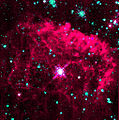File:Hubble Uncovers Brilliant Star in Milky Way's Core (opo9733a).tiff
Hubble_Uncovers_Brilliant_Star_in_Milky_Way's_Core_(opo9733a).tiff (505 × 508 pixels, file size: 688 KB, MIME type: image/tiff)
Captions
Captions
Summary
[edit]| DescriptionHubble Uncovers Brilliant Star in Milky Way's Core (opo9733a).tiff |
English: One of the intrinsically brightest stars in our galaxy appears as the bright white dot in the center of this image taken with the NASA/ESA Hubble Space Telescope. Hubble's Near Infrared Camera and Multi-Object Spectrometer (NICMOS) was needed to take the picture, because the star is hidden at the galactic center, behind obscuring dust. NICMOS' infrared vision penetrated the dust to reveal the star, which is glowing with the radiance of 10 million suns.One of the intrinsically brightest stars in our galaxy appears as the bright white dot in the centre of this image taken with the NASA/ESA Hubble Space Telescope. Hubble's Near Infrared Camera and Multi-Object Spectrometer (NICMOS) was needed to take the picture, because the star is hidden at the galactic center, behind obscuring dust. NICMOS' infrared vision penetrated the dust to reveal the star, which is glowing with the radiance of 10 million suns. |
| Date | 8 October 1997 (upload date) |
| Source | Hubble Uncovers Brilliant Star in Milky Way's Core |
| Author | Don F. Figer (UCLA), and NASA/ESA |
| Other versions |
|
Licensing
[edit]| Public domainPublic domainfalsefalse |
This file is in the public domain because it was created by NASA and ESA. NASA Hubble material (and ESA Hubble material prior to 2009) is copyright-free and may be freely used as in the public domain without fee, on the condition that only NASA, STScI, and/or ESA is credited as the source of the material. This license does not apply if ESA material created after 2008 or source material from other organizations is in use.
The material was created for NASA by Space Telescope Science Institute under Contract NAS5-26555, or for ESA by the Hubble European Space Agency Information Centre. Copyright statement at hubblesite.org or 2008 copyright statement at spacetelescope.org. For material created by the European Space Agency on the spacetelescope.org site since 2009, use the {{ESA-Hubble}} tag. |
File history
Click on a date/time to view the file as it appeared at that time.
| Date/Time | Thumbnail | Dimensions | User | Comment | |
|---|---|---|---|---|---|
| current | 19:38, 2 August 2024 |  | 505 × 508 (688 KB) | OptimusPrimeBot (talk | contribs) | #Spacemedia - Upload of https://esahubble.org/media/archives/images/original/opo9733a.tif via Commons:Spacemedia |
You cannot overwrite this file.
File usage on Commons
The following page uses this file:
Metadata
This file contains additional information such as Exif metadata which may have been added by the digital camera, scanner, or software program used to create or digitize it. If the file has been modified from its original state, some details such as the timestamp may not fully reflect those of the original file. The timestamp is only as accurate as the clock in the camera, and it may be completely wrong.
| Image title | One of the intrinsically brightest stars in our galaxy appears as the bright white dot in the centre of this image taken with the NASA/ESA Hubble Space Telescope. Hubble's Near Infrared Camera and Multi-Object Spectrometer (NICMOS) was needed to take the picture, because the star is hidden at the galactic center, behind obscuring dust. NICMOS' infrared vision penetrated the dust to reveal the star, which is glowing with the radiance of 10 million suns. |
|---|---|
| Width | 505 px |
| Height | 508 px |
| Bits per component |
|
| Compression scheme | LZW |
| Pixel composition | RGB |
| Number of components | 3 |
| Number of rows per strip | 173 |
| Horizontal resolution | 72 dpi |
| Vertical resolution | 72 dpi |
| Data arrangement | chunky format |
| Software used | Adobe Photoshop CS Windows |
| File change date and time | 17:48, 9 December 2003 |
| Color space | Uncalibrated |


